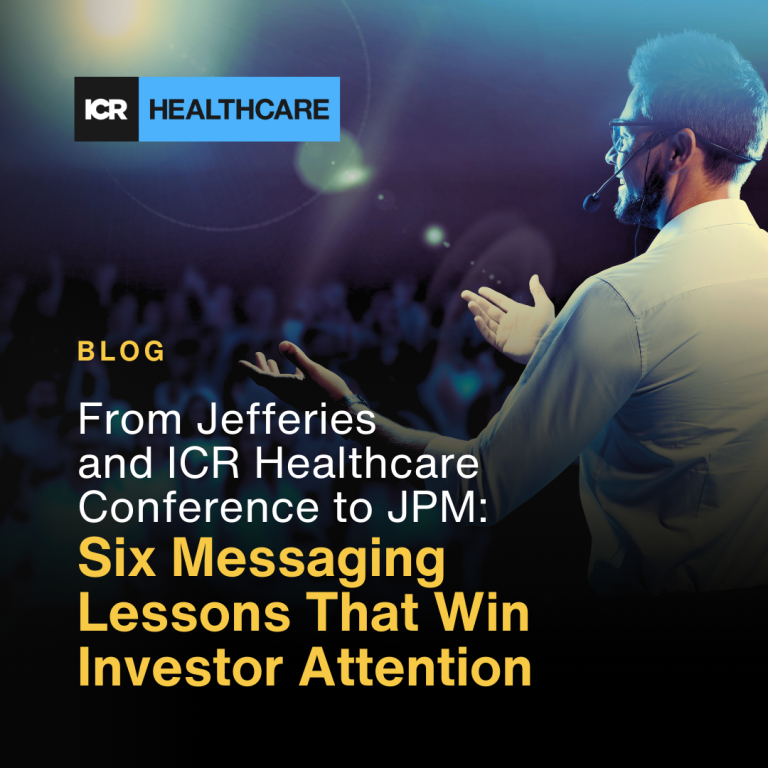It would be great if you could attend every investor conference you’re invited to. After all, they’re an excellent way to tell your story, deepen your relationships with analysts who cover you, begin new relationships with analysts who don’t yet cover you, and ultimately target and attract new investors.
But it’s impossible for any public company to go to all of them. There are more than 100 Wall Street conferences in healthcare alone, and many more focused on growth-oriented companies of any industry.
Instead, you need to carefully select which conferences you attend within the framework of your strategic IR plan, and make sure you’re taking maximum advantage of the opportunity that each event presents. Let’s talk about how.
- It all starts with your plan. Since conference attendance is an important investor relations tactic, it needs to be addressed in your strategic IR plan. The plan serves as the framework in which all of your IR activities occur, including conferences. Your plan will lay out your overall approach to IR conferences, clarify your objectives, and identify the specific conferences you’ll attend.
- Get the lay of the land. Keep a running tally of all the conferences you might attend, categorized by type (healthcare-specific, growth-oriented, or something else), location, sponsor, and expected other attendees. Most companies will attend only about six to eight conferences per year, so you’ll need to choose carefully.
- Get out of New York. You’ll want your conference schedule to be balanced geographically. Make sure you include Boston, the Midwest, and the West Coast in addition to New York. And don’t forget international conferences if you’re looking for international investors.
- Try to keep key analysts happy. There’s often a bit of horse-trading that goes on with conferences. An analyst you’ve targeted may agree to cover your stock, if you agree to attend his or her event. That’s fine. But remember that your existing analysts need attention, too. If you attend only the events of analysts you’ve targeted, the ones already covering you might be insulted.
- Broaden your scope. A good number of the conferences you attend will be healthcare-related, of course, but don’t limit yourself exclusively to healthcare events. Attend conferences aimed at growth-oriented companies too, since some of your potential investors will likely be there.
Who Should Attend?
Once you’ve chosen the conferences you’ll attend, it’s time to decide whom to send. If your market cap is less than $1 billion, this is an easy one: In general, your CEO and CFO should attend, and no one else. Larger companies can get away with sometimes sending only the CFO, or even the IRO or a large division head, provided the CEO shows up at other events. But most companies don’t have the flexibility of delegating conference responsibilities down the organizational chart. Your investors and potential investors expect to see the CEO and CFO, in person, at least a handful of times a year.
Build Your Strategy for Each Event
Next, assemble your strategy for maximizing value from each conference.
First, decide with whom you’ll want to meet while you’re there. Do you want to meet only with your current investors, or (more likely) are you hoping to tell your story to key targeted new investors, too? Either way, you want to be sure you’re working with your IR firm (if you use one) and the conference coordinator to help you assemble a meeting schedule that works for you.
We’ve heard companies complain that they’re at the mercy of the conference coordinators to set the schedules. But that’s a misconception (and it’s not one our own clients labor under). The investment banks who host these events want to keep attendees happy and coming back, so they’re very willing to work with you on the composition of your schedule.
However, they’re not privy to your strategic IR plan, so you may have to communicate with them proactively to get the most out of your conference meetings.
Conference coordinators have no way of knowing that a particular institutional investor is one you’ve targeted. So be sure to reach out — both early in the process to let them know your goals, and as the conference nears, to ask how your schedule is shaping up and to find out who’s on your waiting list.
Since you’ll often be meeting with more than one investor at a time, you’ll also want to pay attention to whether like-minded investors are grouped together.
For example, a long-only investor paired with a hedge fund investor might not be a good match. Hedge funds are rarely long-only, so they’ll be looking for different kinds of information. The same goes for a pairing of brand-new investors with those who’ve been with you for a while. The former will have lots of questions for you to which the latter will already know the answer, so those investors will just get in each other’s way.
Again, the conference coordinator isn’t in a position to know this. So the responsibility rests with you and your IR advisor to work with the coordinator to build a schedule that works for you.
Be Prepared and Follow Up
There’s no sense attending a conference if you are not prepared to get the most from the opportunity. So make sure you’re prepared for the event. Have a clear understanding of who you’re meeting with: What’s their investment style? Do they own your stock? What will their likely questions be?
There’s no substitute for good preparation, and it’s incumbent upon your IR advisor to help you be ready.
Feedback coming out of the meeting is crucial, too, so your IR firm should also be tracking your interactions with your existing and potential investors and making sure you deliver any follow up information to them that they need.
For public companies, investor conferences are unavoidable. And while they take time to prepare for and attend, you should view them as a welcome opportunity to spread your news, build relationships, and generate enthusiasm for your stock. They key is to choose your conferences wisely, and to maximize the value of each one. For more help on selecting and preparing for investor conferences, just reach out.



